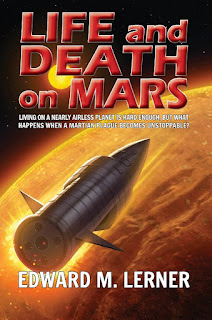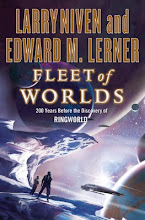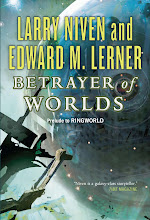There's lots of news this post from the realms of physics, technology, and SF.
(But first ... a few days ago this blog added a syndication outlet, through my authorial page at the massively popular book-review site Goodreads. If you're a newcomer to
SF and Nonsense: welcome! [And an FYI: for unknown reasons, formatting and layout suffer a bit in the syndication. Posts are easier to read if you click through the link "View more on Edward M. Lerner's website."])
 |
| A Higgs going to pieces? |
Is the Higgs boson coming out of hiding? If yes -- which would mean particle physics is
finally going to have a basis for believing it understands the notion of mass -- will the long-reigning
Standard Model of particle physics be collateral damage? From
Ars Technica a few weeks ago, see: "
Hiding in the Higgs data: hints of physics beyond the standard model."
Proof that the Higgs exists would be
huge.
Even a hint that it had been found was a major story. But the biggest physics news in 2011 was the evidence for faster-than-light neutrinos. Hardly anyone believed the FTL measurement -- least of all the researchers reporting it -- but that's what the preliminary data seemed to say.
And so, there were crosschecks, retests, and independent experiments. That's how science is (or should be) done -- even when the results
aren't surprising. And the outcome? In March, "
2nd neutrino team refutes faster-than-light find." In April, the "
Leader of Controversial 'Faster-Than-Light' Physics Experiments Resigns" amid growing controversy over the flawed experiments. And just days ago, from "
Final Nail? Faster-Than-Light Neutrinos Aren't, Scientists Conclude"):
The same lab that first reported the shocking results last September, which could have upended much of modern physics, has now reported that the subatomic particles called neutrinos "respect the cosmic speed limit.
Bottom-lining it, Einstein once again has his laurels intact. That's a big part of what makes the is-it-or-isn't-it status of the Higgs boson so interesting. The Standard Model is part and parcel of quantum mechanics, and the quantum-mechanical view of the universe is inherently
discontinuous. (Hence those quirky quanta. Say that quickly ten times.) Relativity has an inherently
continuous view of the universe. For more than a century, physicists have tried to reconcile these two great -- and very different -- models of The Way Nature Works.
As physicist John Wheeler brilliantly summarized Einsteinian general relativity, "Matter tells space-time how to curve, and space-time tells matter how to move." Imagine that the Higgs boson shows up tomorrow to validate the particle physicist's understanding of matter's attribute of mass. We'll still need an explanation for how space-time gets curved.
But that's enough (heh heh) heavy stuff for one post. Let's lighten things up.
































